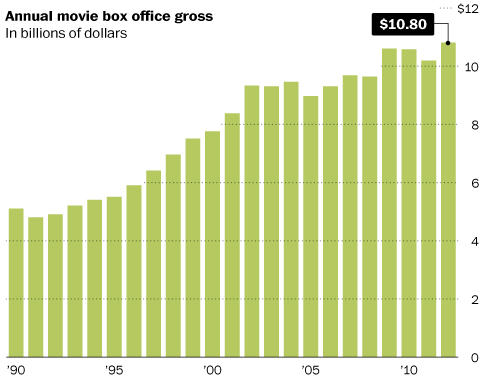
Hot Topics
What Radio Can Learn from the Movies
February 21, 2013
In the 1980s VCRs burst onto the scene. Now people could watch movies at home, without commercial interruption, when they wanted. Many proclaimed this advancement the death of the movie theater. Over the past 33 years, a lot has changed. People’s televisions have gone from a 19” tube to a 60” high-definition flat screen with theater-like surround sound. There are numerous commercial-free movie channels, and on-demand video is now available to most Americans.
Anyone observing this phenomenon would conclude that the movie theater business is dead. Why leave your home, pay for a ticket, and eat overpriced snacks, when you can watch that same movie at home in just a few short weeks in the comfort of your own home?
However, the reality is different. Box office receipts have been on a steady rise, and saw their highest level ever in 2012. The 2012 growth was also significant since it was achieved without an increase in average ticket price. (Source: Wall Street Journal)
With new competition and the movie viewers’ divided attention, how did the old-line movie theater thrive? Theater owners were not complacent. They saw these changes in entertainment options for what they were, a threat to their business model.
So what did they do?
Movie theaters upgraded their environment. New theaters have stadium seating, more comfortable chairs, and a visual and sound experience that greatly exceeds any home theater. IMAX and 3-D, which were once a gimmick, have transformed into a mainstay for many theaters. Simply put, they invested in their product to create an environment that people were willing to pay for.
So how does this relate to our industry? While our challenges started when television became common in American’s living rooms, the competition has become more acute. Digital-only services offer music on demand tailored to your taste, while satellite radio offers more channels than can be picked up on a radio in any market. They often market themselves as “radio – only better.” But are they?
Like the movie theaters, we need to upgrade the environment that our audience experiences when they visit our station. This is not only what comes out of the speakers; your audience must have a positive experience in all aspects of the radio station. This includes the station web experience and every time the station is out on the street.
Radio needs to build and reinforce that local companionship and be part of the community, which the others cannot offer. When they open up the mic, personalities need to remind themselves that people come to them for companionship, entertainment, and information. Give it to them. What is important to your listeners should be what you are talking about.
Don’t forget to promote your advantage. While marketing dollars are few, and therefore it is difficult to grow cume, make sure you let existing listeners know how really good you are. Show that they are part of the station’s community and that the opportunity to listen to your radio station is a way to participate in “their” community.
The final advantage we can also learn from the movies comes down to one word: first. If you want to be one of the first to see that movie, you still have to buy a ticket. If you want to be the first to hear that song, or first to find out what is going on, you must tune to your station.
Remember, theaters were competing with a less expensive, easier to access, alternative. We, as radio broadcasters, do not have that barrier.
-Charlie Sislen, Partner

Comments